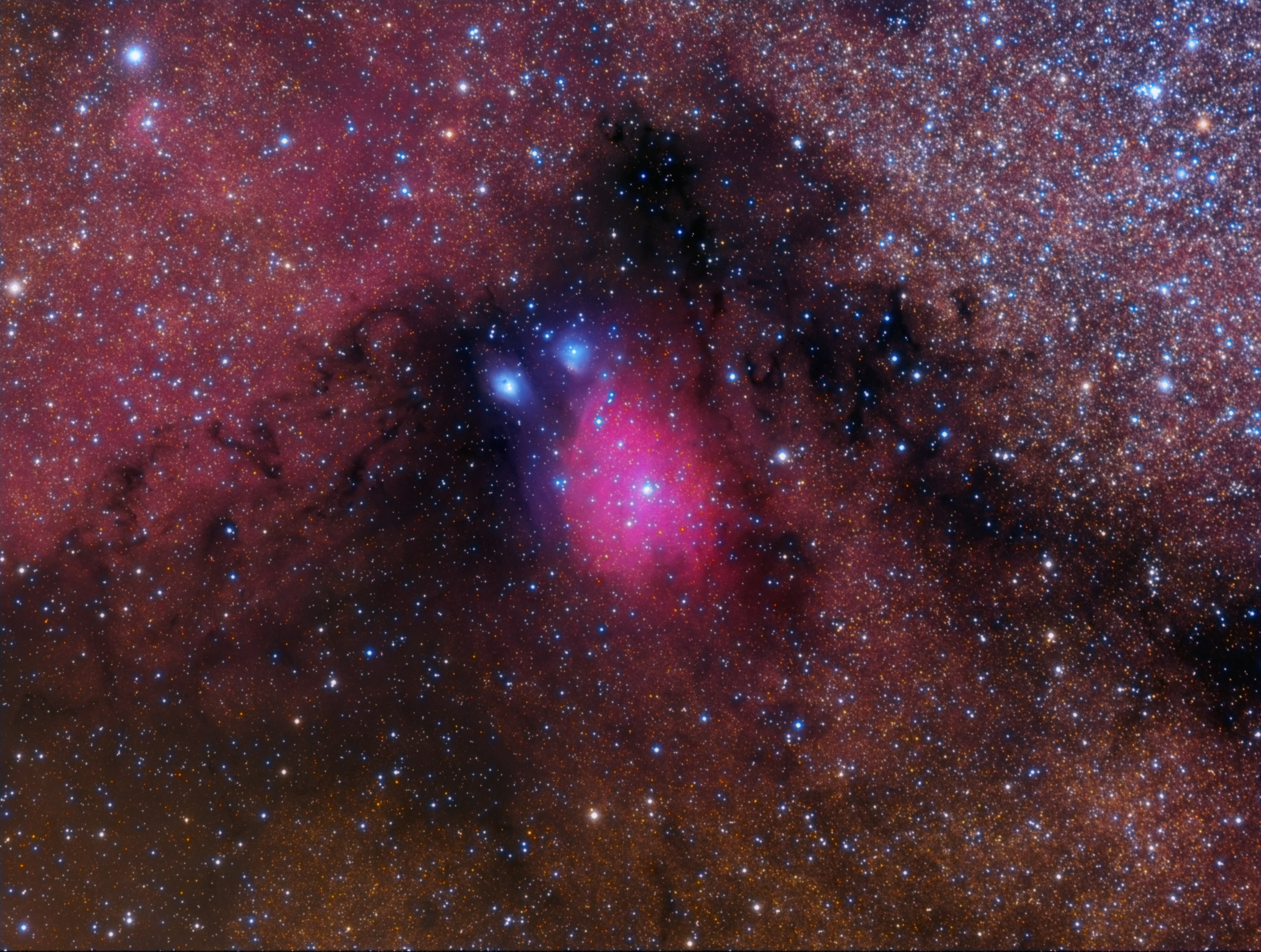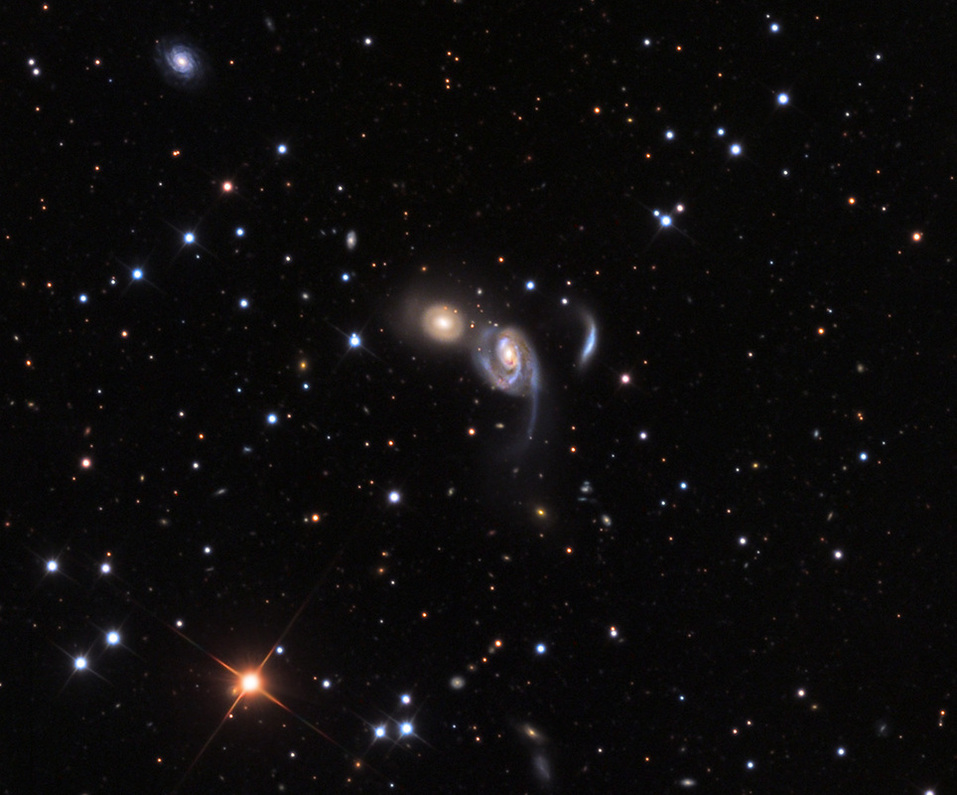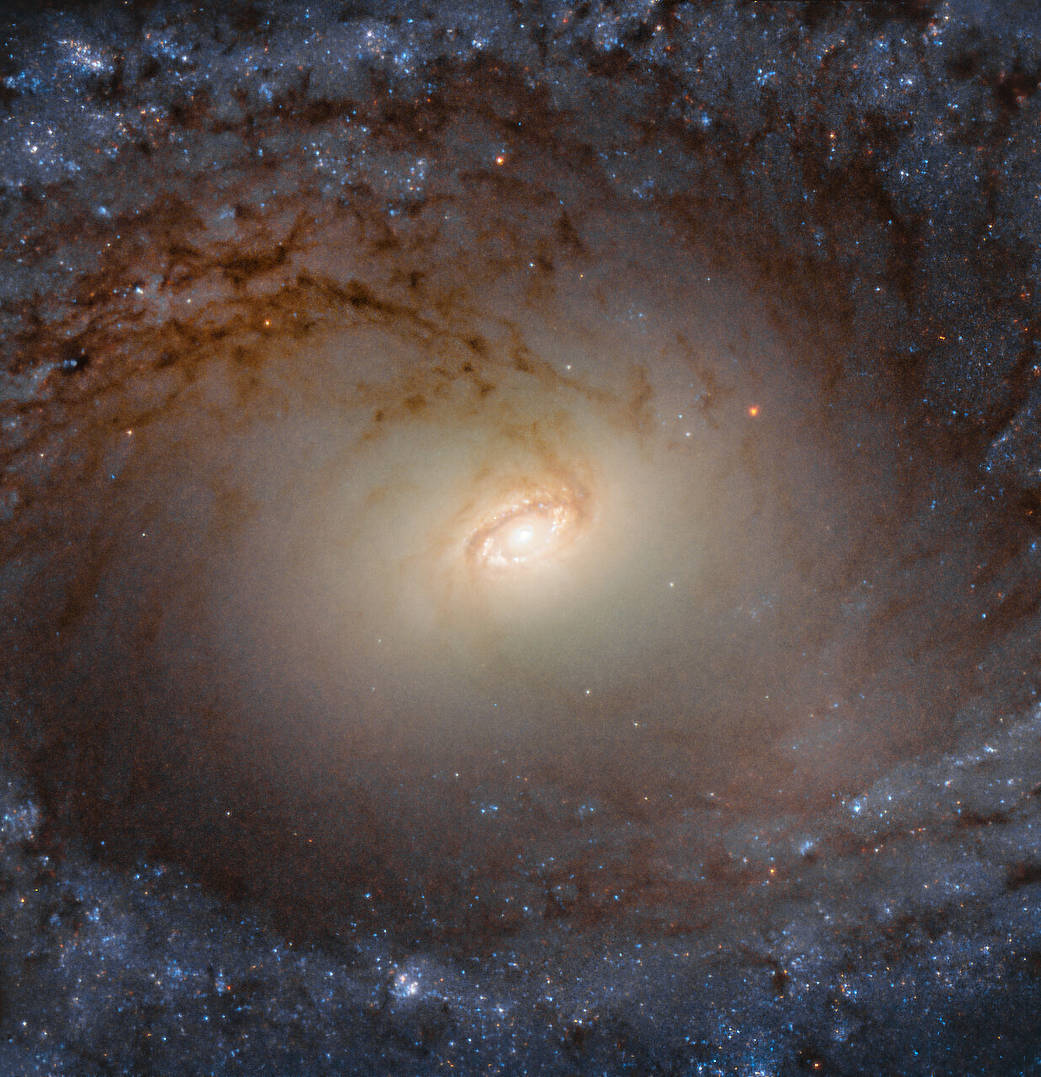Blog
A photographic rate target in Sagittarius near M8 & M20. The emittion nebula IC1283-4 are in the center with are near center with the two small reflection nebulae NGC6589-90. The Dark V shaped nebulae are named vdB118 & 119. Approximately 100,000 light years away.

Dobet Gnahoré (born June 17, 1982) is a singer from Côte d’Ivoire. The daughter of percussionist Boni Gnahoré, she plays with the group Na Afriki, consisting mainly of French and Tunisian musicians, who accompany her with the guitar, sanza, the balafon, the calebasse and bongos. Due to the civil war, she moved to France in 1999. In 2004, Gnahoré released her debut album Ano Neko. In 2006. She was a nominee at the World music (Awards) for Newcomer and shared an award for Best Urban/Alternative Performance with India.Arie at the 52nd Grammy Awards.
https://www.youtube.com/watch?v=GcwuG9ZjOEw
more...Charles Walter Rainey III (born June 17, 1940 in Cleveland, Ohio, United States) is an American bass guitarist who has performed and recorded with many well-known acts, including Aretha Franklin, Steely Dan, and Quincy Jones.
By the 1970s he had played with Jerome Richardson, Grady Tate, Mose Allison, Gato Barbieri, and Gene Ammons, as well as with Eddie Vinson at the 1971 Montreux Festival.
While his “sideman” philosophy of bass has not brought him the level of recognition of star players such as Jaco Pastorius, Rainey has recorded extensively.
On November 5, 2011, Rainey had a stroke.
more...Tony Scott (born Anthony Joseph Sciacca June 17, 1921 – March 28, 2007) was an American jazz clarinetist and arranger with an interest in folk music around the world. For most of his career he was held in high esteem in new-age music circles because of his involvement in music linked to Asian cultures and to meditation.
Born in Morristown, New Jersey, Scott attended Juilliard School from 1940 to 1942. In the 1950s he worked with Sarah Vaughan and Billie Holiday. He also had a young Bill Evans and Paul Motian as side-men on several albums released between 1957 and 1959. In the late 1950s he won on four occasions the Down Beatcritics poll for clarinetist in 1955, 1957, 1958 and 1959. He was known for a more “cool” style than Buddy DeFranco.
Despite this he remained relatively little-known as the clarinet had been in eclipse in jazz since the emergence of bebop. In 1959 he left New York City, where he had been based, and abandoned the United States for a time. In the 1960s he toured South, East, and Southeast Asia. This led to his playing in a Hindu temple, spending time in Japan, and releasing Music for Zen Meditation in 1964 for Verve Records. In 1960 a Down Beat poll for Japan saw readers there name him best clarinetist while the United States preferred Buddy DeFranco. More recently he did a Japanese special on Buddhism and Jazz, although he continued to work with American jazz musicians and played at the Newport Jazz Festival in 1965. In the years following that he worked in Germany, Africa, and at times in South America.
He settled in Italy in the 1970s, working with Italian jazz musicians such as Franco D’Andrea and Romano Mussolini. He also played the part of a Sicilian-American Mafia boss in Glauber Rocha‘s film Claro (1975). In later years he began showing an interest in Electronica and in 2002 his Hare Krishna was remixed by King Brittas a contribution to Verve Remixed.
more...Igor Fyodorovich Stravinsky ComSE (/strəˈvɪnski/; Russian: Игорь Фёдорович Стравинский, IPA: [ˈiɡərʲ ˈfʲɵdərəvʲɪtɕ strɐˈvʲinskʲɪj]; 17 June [O.S. 5 June] 1882 – 6 April 1971) was a Russian-born composer, pianist, and conductor. He is widely considered one of the most important and influential composers of the 20th century.
Stravinsky’s compositional career was notable for its stylistic diversity. He first achieved international fame with three ballets commissioned by the impresario Serge Diaghilev and first performed in Paris by Diaghilev’s Ballets Russes: The Firebird (1910), Petrushka (1911), and The Rite of Spring (1913). The latter transformed the way in which subsequent composers thought about rhythmic structure and was largely responsible for Stravinsky’s enduring reputation as a musical revolutionary who pushed the boundaries of musical design. His “Russian phase”, which continued with works such as Renard, L’Histoire du soldat, and Les Noces, was followed in the 1920s by a period in which he turned to neoclassicism. The works from this period tended to make use of traditional musical forms (concerto grosso, fugue, and symphony) and drew from earlier styles, especially those of the 18th century. In the 1950s, Stravinsky adopted serial procedures. His compositions of this period shared traits with examples of his earlier output: rhythmic energy, the construction of extended melodic ideas out of a few two- or three-note cells, and clarity of form and instrumentation.
more...Its All Over Now/Last Time Reggae/Dub mix by mick L
Broadcast this Friday June 19th 2020 on Zoom with local Reggae Artists of the Twin Cities production & hosting by Chilly Petrus
https://www.youtube.com/watch?v=uCcNcHx2DpY
more...NGC 7806 (also known as Arp 112 , MCG 5-1-25 , PGC 112, and UGC 12911 ) is a spiral galaxy about 219 million sg away from Earthand located in the constellation Pegasus . The largest diameter is 1.10 (70 thousand sg) and the smallest 0.8 angular minutes (51 thousand sg). first discovery was made by John Frederick William Herschel on October 9, 1790 . years.

Olufela Olufemi Anikulapo Kuti (born 16 June 1962), popularly known as Femi Kuti, is a Nigerian musician born in London and raised in Lagos. He is the eldest son of Afrobeat pioneer Fela Kuti and a grandchild of political campaigner, women’s rights activist and traditional aristocrat Funmilayo Ransome Kuti.
Femi Kuti began his musical career playing in his father’s band, Egypt 80. In 1986, Femi started his own band, Positive Force, establishing himself as an artist independent of his father’s massive legacy.
Femi Anikulapo Kuti was born in London to Fela and Remilekun (Remi) Ransome-Kuti (née Taylor; 1961–1985), and grew up in the former Nigerian capital, Lagos. His mother soon left his father, taking Femi to live with her. In 1977, however, Femi chose to move in with his father. Femi started playing the saxophone at the age of 15 and eventually became a member of his father’s band. He studied at Baptist Academy and Igbobi College.
more...Edward Willis Levert (born June 16, 1942) is an American singer–songwriter and actor. Levert is best known as the lead vocalist of the group, The O’Jays.
Levert was born in Bessemer, Alabama, but was raised in Canton, Ohio, where he moved to at the age of 6. He attended church regularly and eventually joined the church choir. As Levert continued singing into his teenage years, he became a recognized voice in the church choir, sang in school plays and performed regularly on a gospel radio show.
By the time he reached high school, young Levert knew that singing was what he wanted to do, teaming up with classmates Walter Williams, William Powell, Bobby Massey and Bill Isles to form a group called the Triumphs. The Triumphs played locally in Canton opening for different acts, playing sock hops and just about everything that came up. Their big break came when The Triumphs traveled to Cincinnati to canvas King Records. King Records President Sid Nathan, immediately impressed, changed their name to The Mascots and signed them to his label. The Mascots’ popularity grew as their songs could be heard with increased frequency on Cleveland radio stations.
In 1969, The O’Jays signed with Philadelphia International Records where they released hit after hit and were propelled to stardom. The O’Jays later signed with EMI-Manhattan Records and Levert and Williams began co-writing and producing their own tracks. Their EMI debut album, “Let Me Touch You”, went to number three R&B and boasted “Lovin’ You,” the number one R&B hit from the summer 1987.
more...Alfred Viola (June 16, 1919 – February 21, 2007) was an American jazz guitarist who worked with Frank Sinatra for 25 years and also played the mandolin on the soundtrack of the film The Godfather.
Viola grew up in an Italian family in Brooklyn, and learned to play the guitar and mandolin as a teenager. He enlisted in the Army during World War IIfrom 1942 to 1945 and played in an Army jazz band. After he was discharged in 1946, he and Page Cavanaugh, whom he had met while serving in the Army, along with joined bassist Lloyd Pratt, formed a trio. The ensemble appeared in several films, including the Doris Day vehicle Romance on the High Seas, and played a few dates in 1946 and 1947 with Frank Sinatra. Viola continued to work with Sinatra regularly, accompanying him on several hundred studio recordings and concert dates between 1956 and 1980.
Viola was a highly regarded session musician in Los Angeles, performing in films, on television and in commercial spots. His mandolin playing can be heard on the soundtrack of The Godfather; other credits include West Side Story and Who’s Afraid of Virginia Woolf?. He continued playing jazz as well, with Bobby Troup, Ray Anthony, Harry James, Buddy Collette, Stan Kenton, Gerald Wilson and Terry Gibbs. He also worked as a session musician on over 500 albums, including releases by Jimmy Witherspoon, Helen Humes, June Christy, Natalie Cole, Neil Diamond, Ella Fitzgerald, Marvin Gaye, Steve Lawrence, Julie London, Anita O’Day, Nelson Riddle, Linda Ronstadt and Joe Williams.
more...This image from the NASA/ESA Hubble Space Telescope shows IC 2051, a galaxy in the southern constellation of Mensa (the Table Mountain) lying about 85 million light-years away. It is a spiral galaxy, as evidenced by its characteristic whirling, pinwheeling arms, and it has a bar of stars slicing through its center.
This galaxy was observed for a Hubble study on galactic bulges, the bright round central regions of spiral galaxies. Spiral galaxies like IC 2051 are shaped a bit like flying saucers when seen from the side; they comprise a thin, flat disk, with a bulky bulge of stars in the center that extends above and below the disk. These bulges are thought to play a key role in how galaxies evolve, and to influence the growth of the supermassive black holes lurking at the centers of most spirals. While more observations are needed in this area, studies suggest that some, or even most, galactic bulges may be complex composite structures rather than simple ones, with a mix of spherical, disk-like, or boxy components, potentially leading to a wide array of bulge morphologies in the universe.
This image comprises data from Hubble’s Wide Field Camera 3 at visible and infrared wavelengths.

More Posts
- Attila Zoller Day
- Wild Bill Moore Day
- Don Cheatham Day
- World Music with Slonovski Bal
- Daily Roots with Playing for Change
- The Cosmos with NGC 660
- Peter Beets Day
- Chick Corea Day
- World Music with Jacky Molard
- Daily Roots with Steel Pulse
- The Cosmos with GGD 27
- Hazel Scott Day
- Bernard Purdie Day
- Shelly Manne Day
- World Music with Orchestre National de Barbés
- Daily Roots with Bunny Wailer & Ruffi-Ann
- The Cosmos with NGC 6543
- Gary Thomas Day
- João Gilberto Day
- Howlin’ Wolf Day